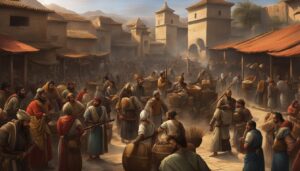
Ancient navigation played a significant role in biblical stories, particularly in the maritime journeys undertaken by ancient sailors. The use of navigation techniques in the Bible is evident in the various references to biblical journeys by sea. These journeys were made possible through the exploration and utilization of historical navigation methods by the ancient seafarers. The stories in the Bible often mention the importance of navigation for trade, communication, and the spread of religious beliefs across different regions.
Key Takeaways:
- Ancient navigation was crucial for the maritime journeys mentioned in biblical stories.
- The Bible highlights the role of navigation in trade, communication, and the spread of religious beliefs.
- Ancient sailors utilized historical navigation methods to navigate the seas.
- Exploration and navigation were instrumental in connecting different regions during biblical times.
- The stories in the Bible emphasize the significance of navigation in various aspects of life.
Types of Bible Map Products
When it comes to Bible map products, there is a wide range of options available to the modern reader. These maps provide valuable insights into the geographical context of biblical stories and help us visualize the locations mentioned in the Bible. Let’s explore some of the different types of Bible maps and their varying levels of quality and detail.
Basic Bible Maps
Basic Bible maps are often found in the back of physical Bibles. These maps offer a general overview of ancient cities, important regions, and key locations mentioned in the Bible. While these maps provide a basic understanding of the biblical narrative, they may lack the level of detail needed for in-depth study and analysis.
Commentaries, Study Bibles, and Bible Surveys
Commentaries, study Bibles, and Bible surveys often include maps that are contextualized to the specific content being discussed. These maps are designed to enhance the reader’s understanding of the text and provide valuable insights into the geographical aspects of biblical stories. They are typically more detailed than basic Bible maps and offer additional information that aids in interpretation.
Specialized Resources: Books of Maps and Charts, Bible Atlases
For a more comprehensive collection of maps and charts, specialized resources like books of maps and charts and Bible atlases are available. These resources offer a deeper exploration of the geographical and historical context of the Bible. They provide detailed maps that showcase boundaries, topography, and routes, allowing readers to delve into the specifics of biblical journeys, events, and locations.
| Type of Bible Map Product | Level of Detail | Scope of Information |
|---|---|---|
| Basic Bible Maps | Low | General overview of key locations |
| Commentaries, Study Bibles, and Bible Surveys | Medium | Contextualized maps enhancing interpretation |
| Specialized Resources: Books of Maps and Charts, Bible Atlases | High | Comprehensive collection with detailed information |
As you explore the world of Bible map products, consider your specific needs and purposes. Basic Bible maps may suffice for casual reading, while those seeking a more in-depth understanding of the biblical narrative may find value in specialized resources. Regardless of the type of Bible map product you choose, these visual aids can greatly enrich your study of the Bible and deepen your appreciation for the historical and geographical context of the stories it contains.
Reasons to Use Bible Maps
The use of Bible maps is essential for understanding the geography, topography, and historical context of biblical narratives. By visualizing the locations mentioned in the Bible, we can gain a deeper appreciation for the journeys, events, and interactions of biblical characters.
One reason to use Bible maps is to determine the distance between locations. In biblical times, travel was arduous and time-consuming. By examining the geographical placement of cities and regions, we can better grasp the physical challenges faced by biblical figures. For example, mapping the distance between Jerusalem and Bethlehem allows us to appreciate the significance of Mary and Joseph’s journey to Bethlehem for Jesus’s birth.
Bible maps also help us understand the topography of the land described in the Bible. The terrain and features of the landscape played a crucial role in shaping the experiences of biblical characters. By examining the elevation, bodies of water, and natural barriers depicted on Bible maps, we can visualize how these factors influenced trade routes, military strategies, and cultural interactions.
“The geography of Palestine has always been important in understanding the development of human history and civilization.”
– Klaudios Ptolemaios, The Geography of the Bible
Furthermore, borders depicted in Bible maps provide insights into the political and historical context of biblical events. Understanding the extent of ancient empires, the division of lands, and the proximity of neighboring nations sheds light on the conflicts, alliances, and cultural exchange described in the Bible. By visually exploring the borders on Bible maps, we gain a greater understanding of the geopolitical dynamics of biblical times.
Ultimately, Bible maps serve as invaluable tools for comprehending the biblical narrative in its geographical and historical context. By utilizing these visual aids, we can enhance our understanding of the journeys, events, and interactions recorded in the Bible, fostering a deeper connection with the stories and teachings within.
Biblical Geography – A Closer Look
| Location | Main Features | Significance |
|---|---|---|
| Jerusalem | Holy city, Temple Mount, Western Wall | Capital of ancient Israel, central to religious worship and pilgrimage |
| Egypt | Nile River, Pyramids, Sphinx | Setting for the story of Moses and the Exodus |
| Babylon | Hanging Gardens, Ishtar Gate | Conqueror of Jerusalem, exile destination for Jewish people |
| Sea of Galilee | Fishing industry, Jesus’s ministry | Significant location for Jesus’s teachings and miracles |

Conclusion
The Bible should be approached as a moral map rather than a moral GPS. While some may seek specific step-by-step directions from the Bible for their moral questions, it is important to recognize that the Bible was not written as a rule book with clear-cut directives for every situation.
Instead, the Bible provides a framework of values and a big picture worldview that guides our moral choices. By studying biblical stories and considering their relevance to our modern context, we can navigate our own moral landscape while remaining grounded in the principles and teachings of the Bible.
This approach encourages critical thinking and personal responsibility, rather than relying solely on unquestioning obedience to specific biblical commands. The Bible serves as a moral compass, offering wisdom and guidance that can be applied to the complexities of our lives.
FAQ
What role did ancient navigation play in biblical stories?
Ancient navigation techniques were utilized by ancient sailors in biblical journeys by sea. These journeys facilitated trade, communication, and the spread of religious beliefs across different regions.
What types of Bible map products are available in the market?
There are various types of Bible map products available, including maps found in the back of physical Bibles, maps in commentaries, study Bibles, and Bible surveys, as well as specialized resources such as books of maps and charts and Bible atlases.
What purposes do Bible maps serve in biblical studies?
Bible maps help determine distance between locations, visualize the topography of the land mentioned in the Bible, offer insights into the political and historical context, and provide a visual representation of specific routes, battles, and events mentioned in the Bible.
How should the Bible be approached in terms of moral guidance?
The Bible should be seen as a moral map rather than a moral GPS. It provides a framework of values and a big picture worldview that guides moral choices, encouraging critical thinking and personal responsibility.








